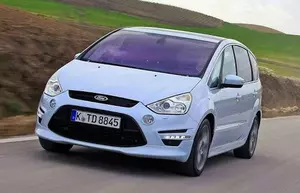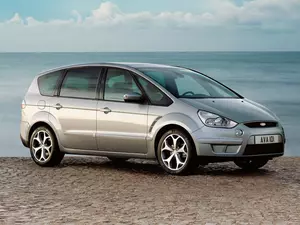
| Vehicle | Curb weight | Difference from world's smallest | Weight to power ratio | 0—60 mph acceleration ratio | Consumption ratio |
|---|---|---|---|---|---|
| 2.0 EcoBlue |
1830 kg / 4035 lbs |
1405 kg (3098 lbs) heavier | 10 kg to 1 hp | 199 kg/s (439 lbs/s) | - |
| 2.0 Bi-Turbo EcoBlue |
1876 kg / 4137 lbs |
1451 kg (3200 lbs) heavier | 8 kg to 1 hp | 229 kg/s (505 lbs/s) | - |
| 1.5 EcoBoost |
1709 kg / 3768 lbs |
1284 kg (2831 lbs) heavier | 10 kg to 1 hp | 176 kg/s (388 lbs/s) | - |
| Vehicle | 2.0 EcoBlue |
|---|---|
| Curb weight |
1830 kg / 4035 lbs |
| Difference from world's smallest | 1405 kg (1405 lbs) heavier |
| Weight to power ratio | 10 kg to 1 hp |
| 0—60 mph acceleration ratio | 199 kg/s (439 lbs/s) |
| Consumption ratio | - |
| Vehicle | 2.0 Bi-Turbo EcoBlue |
| Curb weight |
1876 kg / 4137 lbs |
| Difference from world's smallest | 1451 kg (1451 lbs) heavier |
| Weight to power ratio | 8 kg to 1 hp |
| 0—60 mph acceleration ratio | 229 kg/s (505 lbs/s) |
| Consumption ratio | - |
| Vehicle | 1.5 EcoBoost |
| Curb weight |
1709 kg / 3768 lbs |
| Difference from world's smallest | 1284 kg (1284 lbs) heavier |
| Weight to power ratio | 10 kg to 1 hp |
| 0—60 mph acceleration ratio | 176 kg/s (388 lbs/s) |
| Consumption ratio | - |

| Vehicle | Curb weight | Difference from world's smallest | Weight to power ratio | 0—60 mph acceleration ratio | Consumption ratio |
|---|---|---|---|---|---|
| 1.5 EcoBoost |
1645 kg / 3627 lbs |
1220 kg (2690 lbs) heavier | 10 kg to 1 hp | 175 kg/s (386 lbs/s) |
253 kg/L (558 lbs/L) |
| 2.0 EcoBoost |
1704 kg / 3757 lbs |
1279 kg (2820 lbs) heavier | 7 kg to 1 hp | 213 kg/s (470 lbs/s) |
191 kg/L (421 lbs/L) |
| 2.0 TDCi |
1725 kg / 3804 lbs |
1300 kg (2867 lbs) heavier | 14 kg to 1 hp | 136 kg/s (300 lbs/s) |
345 kg/L (761 lbs/L) |
| 2.0 EcoBlue |
1725 kg / 3804 lbs |
1300 kg (2867 lbs) heavier | 14 kg to 1 hp | 145 kg/s (320 lbs/s) |
338 kg/L (745 lbs/L) |
| 2.0 Bi-Turbo Ecoblue |
1766 kg / 3894 lbs |
1341 kg (2957 lbs) heavier | 7 kg to 1 hp | 215 kg/s (474 lbs/s) |
299 kg/L (659 lbs/L) |
| Vehicle | 1.5 EcoBoost |
|---|---|
| Curb weight |
1645 kg / 3627 lbs |
| Difference from world's smallest | 1220 kg (1220 lbs) heavier |
| Weight to power ratio | 10 kg to 1 hp |
| 0—60 mph acceleration ratio | 175 kg/s (386 lbs/s) |
| Consumption ratio |
253 kg/L (558 lbs/L) |
| Vehicle | 2.0 EcoBoost |
| Curb weight |
1704 kg / 3757 lbs |
| Difference from world's smallest | 1279 kg (1279 lbs) heavier |
| Weight to power ratio | 7 kg to 1 hp |
| 0—60 mph acceleration ratio | 213 kg/s (470 lbs/s) |
| Consumption ratio |
191 kg/L (421 lbs/L) |
| Vehicle | 2.0 TDCi |
| Curb weight |
1725 kg / 3804 lbs |
| Difference from world's smallest | 1300 kg (1300 lbs) heavier |
| Weight to power ratio | 14 kg to 1 hp |
| 0—60 mph acceleration ratio | 136 kg/s (300 lbs/s) |
| Consumption ratio |
345 kg/L (761 lbs/L) |
| Vehicle | 2.0 EcoBlue |
| Curb weight |
1725 kg / 3804 lbs |
| Difference from world's smallest | 1300 kg (1300 lbs) heavier |
| Weight to power ratio | 14 kg to 1 hp |
| 0—60 mph acceleration ratio | 145 kg/s (320 lbs/s) |
| Consumption ratio |
338 kg/L (745 lbs/L) |
| Vehicle | 2.0 Bi-Turbo Ecoblue |
| Curb weight |
1766 kg / 3894 lbs |
| Difference from world's smallest | 1341 kg (1341 lbs) heavier |
| Weight to power ratio | 7 kg to 1 hp |
| 0—60 mph acceleration ratio | 215 kg/s (474 lbs/s) |
| Consumption ratio |
299 kg/L (659 lbs/L) |

| Vehicle | Curb weight | Difference from world's smallest | Weight to power ratio | 0—60 mph acceleration ratio | Consumption ratio |
|---|---|---|---|---|---|
| 2.0 Duratec Durashift |
1605 kg / 3539 lbs |
1180 kg (2602 lbs) heavier | 11 kg to 1 hp | 154 kg/s (340 lbs/s) |
196 kg/L (432 lbs/L) |
| 1.6 Duratorq TDCi |
1703 kg / 3755 lbs |
1278 kg (2818 lbs) heavier | 15 kg to 1 hp | 137 kg/s (302 lbs/s) |
328 kg/L (723 lbs/L) |
| 1.6 EcoBoost SCTi |
1598 kg / 3524 lbs |
1173 kg (2587 lbs) heavier | 10 kg to 1 hp | 172 kg/s (379 lbs/s) |
228 kg/L (503 lbs/L) |
| 2.0 EcoBoost |
1661 kg / 3663 lbs |
1236 kg (2726 lbs) heavier | 7 kg to 1 hp | 221 kg/s (487 lbs/s) |
200 kg/L (441 lbs/L) |
| 2.0 Duratorq TDCi |
1689 kg / 3724 lbs |
1264 kg (2787 lbs) heavier | 10 kg to 1 hp | 174 kg/s (384 lbs/s) |
282 kg/L (622 lbs/L) |
| 2.2 Duratorq TDCi |
1733 kg / 3821 lbs |
1308 kg (2884 lbs) heavier | 9 kg to 1 hp | 204 kg/s (450 lbs/s) |
244 kg/L (538 lbs/L) |
| Vehicle | 2.0 Duratec Durashift |
|---|---|
| Curb weight |
1605 kg / 3539 lbs |
| Difference from world's smallest | 1180 kg (1180 lbs) heavier |
| Weight to power ratio | 11 kg to 1 hp |
| 0—60 mph acceleration ratio | 154 kg/s (340 lbs/s) |
| Consumption ratio |
196 kg/L (432 lbs/L) |
| Vehicle | 1.6 Duratorq TDCi |
| Curb weight |
1703 kg / 3755 lbs |
| Difference from world's smallest | 1278 kg (1278 lbs) heavier |
| Weight to power ratio | 15 kg to 1 hp |
| 0—60 mph acceleration ratio | 137 kg/s (302 lbs/s) |
| Consumption ratio |
328 kg/L (723 lbs/L) |
| Vehicle | 1.6 EcoBoost SCTi |
| Curb weight |
1598 kg / 3524 lbs |
| Difference from world's smallest | 1173 kg (1173 lbs) heavier |
| Weight to power ratio | 10 kg to 1 hp |
| 0—60 mph acceleration ratio | 172 kg/s (379 lbs/s) |
| Consumption ratio |
228 kg/L (503 lbs/L) |
| Vehicle | 2.0 EcoBoost |
| Curb weight |
1661 kg / 3663 lbs |
| Difference from world's smallest | 1236 kg (1236 lbs) heavier |
| Weight to power ratio | 7 kg to 1 hp |
| 0—60 mph acceleration ratio | 221 kg/s (487 lbs/s) |
| Consumption ratio |
200 kg/L (441 lbs/L) |
| Vehicle | 2.0 Duratorq TDCi |
| Curb weight |
1689 kg / 3724 lbs |
| Difference from world's smallest | 1264 kg (1264 lbs) heavier |
| Weight to power ratio | 10 kg to 1 hp |
| 0—60 mph acceleration ratio | 174 kg/s (384 lbs/s) |
| Consumption ratio |
282 kg/L (622 lbs/L) |
| Vehicle | 2.2 Duratorq TDCi |
| Curb weight |
1733 kg / 3821 lbs |
| Difference from world's smallest | 1308 kg (1308 lbs) heavier |
| Weight to power ratio | 9 kg to 1 hp |
| 0—60 mph acceleration ratio | 204 kg/s (450 lbs/s) |
| Consumption ratio |
244 kg/L (538 lbs/L) |

| Vehicle | Curb weight | Difference from world's smallest | Weight to power ratio | 0—60 mph acceleration ratio | Consumption ratio |
|---|---|---|---|---|---|
| 1.8 TDCi |
1744 kg / 3846 lbs |
1319 kg (2909 lbs) heavier | 14 kg to 1 hp | 159 kg/s (351 lbs/s) |
281 kg/L (620 lbs/L) |
| 2.0 i 16V |
1605 kg / 3539 lbs |
1180 kg (2602 lbs) heavier | 11 kg to 1 hp | 154 kg/s (340 lbs/s) |
198 kg/L (437 lbs/L) |
| 2.0 TDCi |
1736 kg / 3828 lbs |
1311 kg (2891 lbs) heavier | 12 kg to 1 hp | 179 kg/s (395 lbs/s) |
271 kg/L (598 lbs/L) |
| 2.2 TDCi |
1736 kg / 3828 lbs |
1311 kg (2891 lbs) heavier | 10 kg to 1 hp | 195 kg/s (430 lbs/s) |
263 kg/L (580 lbs/L) |
| 2.3 T |
1605 kg / 3539 lbs |
1180 kg (2602 lbs) heavier | 10 kg to 1 hp | 151 kg/s (333 lbs/s) |
169 kg/L (373 lbs/L) |
| 2.5 i 20V |
1681 kg / 3707 lbs |
1256 kg (2770 lbs) heavier | 8 kg to 1 hp | 224 kg/s (494 lbs/s) |
179 kg/L (395 lbs/L) |
| Vehicle | 1.8 TDCi |
|---|---|
| Curb weight |
1744 kg / 3846 lbs |
| Difference from world's smallest | 1319 kg (1319 lbs) heavier |
| Weight to power ratio | 14 kg to 1 hp |
| 0—60 mph acceleration ratio | 159 kg/s (351 lbs/s) |
| Consumption ratio |
281 kg/L (620 lbs/L) |
| Vehicle | 2.0 i 16V |
| Curb weight |
1605 kg / 3539 lbs |
| Difference from world's smallest | 1180 kg (1180 lbs) heavier |
| Weight to power ratio | 11 kg to 1 hp |
| 0—60 mph acceleration ratio | 154 kg/s (340 lbs/s) |
| Consumption ratio |
198 kg/L (437 lbs/L) |
| Vehicle | 2.0 TDCi |
| Curb weight |
1736 kg / 3828 lbs |
| Difference from world's smallest | 1311 kg (1311 lbs) heavier |
| Weight to power ratio | 12 kg to 1 hp |
| 0—60 mph acceleration ratio | 179 kg/s (395 lbs/s) |
| Consumption ratio |
271 kg/L (598 lbs/L) |
| Vehicle | 2.2 TDCi |
| Curb weight |
1736 kg / 3828 lbs |
| Difference from world's smallest | 1311 kg (1311 lbs) heavier |
| Weight to power ratio | 10 kg to 1 hp |
| 0—60 mph acceleration ratio | 195 kg/s (430 lbs/s) |
| Consumption ratio |
263 kg/L (580 lbs/L) |
| Vehicle | 2.3 T |
| Curb weight |
1605 kg / 3539 lbs |
| Difference from world's smallest | 1180 kg (1180 lbs) heavier |
| Weight to power ratio | 10 kg to 1 hp |
| 0—60 mph acceleration ratio | 151 kg/s (333 lbs/s) |
| Consumption ratio |
169 kg/L (373 lbs/L) |
| Vehicle | 2.5 i 20V |
| Curb weight |
1681 kg / 3707 lbs |
| Difference from world's smallest | 1256 kg (1256 lbs) heavier |
| Weight to power ratio | 8 kg to 1 hp |
| 0—60 mph acceleration ratio | 224 kg/s (494 lbs/s) |
| Consumption ratio |
179 kg/L (395 lbs/L) |